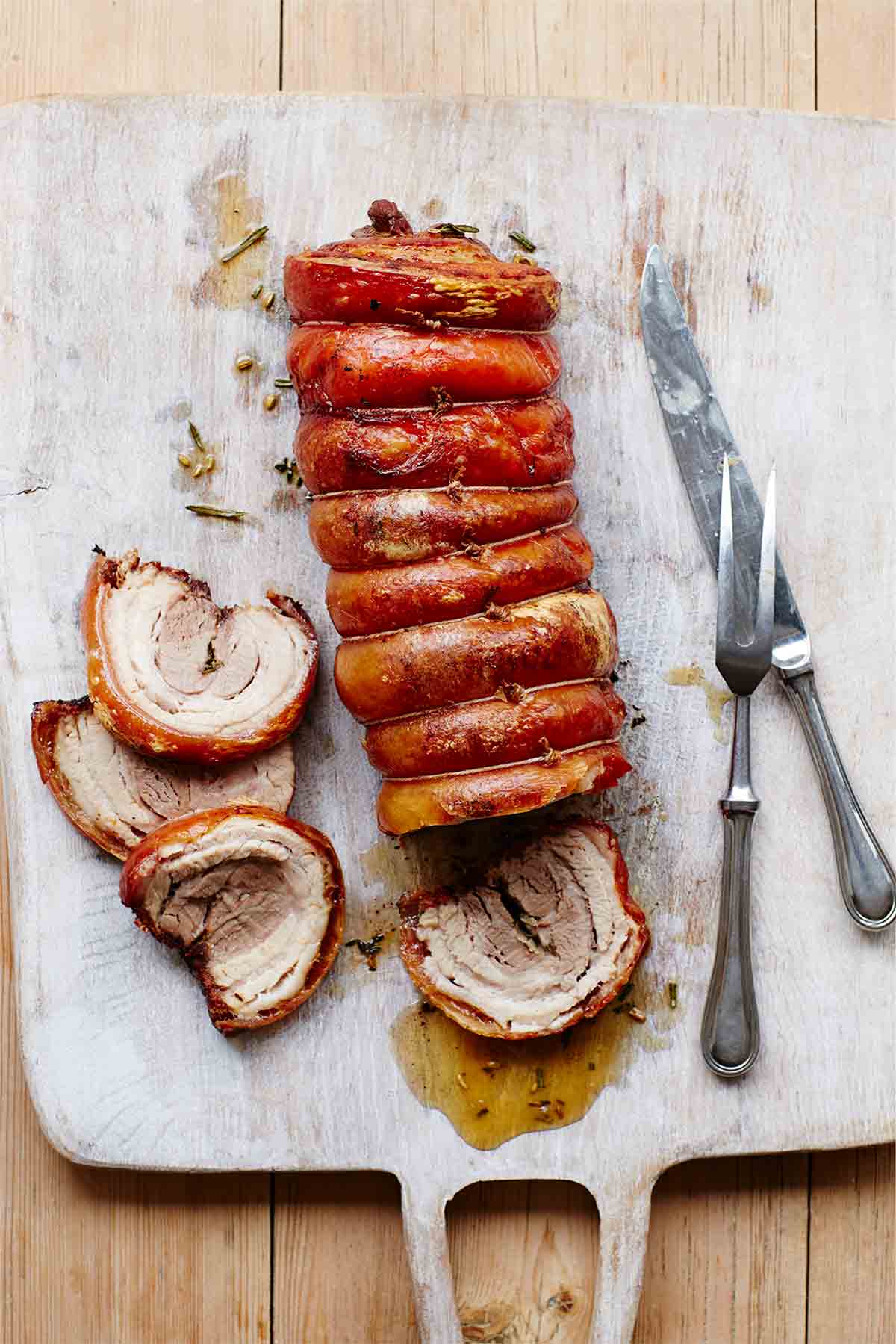
In this contemporary riff on traditional Italian porchetta, pork belly is infused with fennel seeds, thyme, rosemary, and, unexpectedly, honey. It’s left to cook low and sloooooooooow to create a tantalizingly and mind-bendingly tender pork belly porchetta. The American infatuation with all things pork belly continues. You can halve the recipe if you’re so inclined, though we think once you taste this pork belly porchetta, you’re going to want to make as much of it as humanly possible.–Renee Schettler Rossi

Pork Belly Porchetta
Equipment
- Butcher’s string or kitchen string; instant-read thermometer
Ingredients
- 10 pounds skin-on, boneless pork belly, butterflied in a single rectangular piece
- Freshly ground black pepper
- 2 tablespoons coarse sea salt
- 2 sprigs thyme, leaves stripped from the stems
- 2 tablespoons roughly chopped rosemary leaves
- 1 tablespoon fennel seeds
- 10 garlic cloves, finely chopped
- 2 tablespoons extra-virgin olive oil, plus more for the roasting pan
- 6 tablespoons honey
- Juice of 2 limes
Instructions
- Preheat the oven to 475°F (250°C).
- Pat the pork belly dry and place it, skin side down, on a cutting board. Sprinkle the meat with pepper and half the salt and rub it in. Let it rest for 5 minutes.
- Sprinkle the thyme, rosemary, and fennel seeds over the pork and rub it in along with the garlic. Gently roll up the pork and tie it crosswise with pieces of butcher’s string at 1/2-inch (1-centimeter) intervals. Try to keep as much of the garlic and herb rub inside the pork as possible…although if a little filling spills out, it's not the end of the world.
- Coat a roasting pan with a little oil and place the pork in it. Using your hands, spread the remaining 1 tablespoon salt along with the 2 tablespoons oil all over the outside of the pork. Turn the pork seam side up. Roast the pork, uncovered, for 15 minutes, then turn it over and roast for another 15 minutes. Reduce the oven temperature to 300°F (150°C) and cook for 2 1/2 to 3 hours more, until the center of the pork registers 165°F (74°C) on an instant-read thermometer.
- Remove the pan from the oven. Add the honey and lime juice to the pan drippings. If desired, while the pork is still in the roasting pan, turn to coat it with the pan juices and honey and lime juice, although this will elminate any chance of shatteringly crisp skin atop the roast. But it will be tasty. https://leitesculinaria.com/wp-admin/post.php?post=98646&action=edit#
- Transfer the pork to a cutting board and let it rest for at least 10 minutes.
- Skim the fat from the surface of the cooking juices in the roasting pan and discard. Pour the juices into a warmed bowl and stir.
- Cut the pork into thick slices, discarding the butcher's string, and place on a platter. Pass the bowl of juices on the side.
Explore More with AI
Nutrition
Nutrition information is automatically calculated, so should only be used as an approximation.
Recipe Testers’ Reviews
Can you say “ultimate weekend project”? One that will bring delicious tidings to you for the rest of the week? You need to make this recipe.
I halved the recipe and started out with a 5-pound slab of skin-on pork belly. My butcher trimmed the meat to a nice squarish shape that was approximately 12 inches long by 15 inches wide. I don’t have a roasting pan, so I used a big, deep cast-iron skillet that I first heated on the stove for a few minutes, just to move things along. Make sure you put the pork roll in seam side up for the initial high-heat roast at 475°F. Then when you lower the heat to 300°F, flip the meat over so the presentation side is up and the seam is down. I roasted this baby for about 2 hours and 45 minutes at 300°F.
What a beautiful sight to see, all picture-perfect with golden brown skin. All those rich rings of belly fat and tender dark meat with stuffing. I let the porchetta rest for 20 minutes on the cutting board. I served it like they do in Rome, as a sandwich with broccoli rabe rich with garlic, grated Parmigiano-Reggiano, and the tender dark meat of the porchetta, all on a semolina roll. And yes, I drizzled some of that incredible rendered fat right onto the sandwich before closing it up. What a heavenly few days we had snacking on this project.
A few notes on rolling and cooking the pork for this porchetta recipe. First thing you need to do is check to see if there aren’t in fact a few small spareribs (no pun intended) that may still be connected to the belly side. You will need to remove those, as it will hinder an even roll (or a roll at all). Next, I suggest you score the skin in a diamond pattern in an effort to improve your chances of getting coveted pork skin cracklings. I seasoned the meat and spread the stuffing as directed. Time to rock and roll.
For this size belly, you will need eight 18-inch lengths of very good, strong butcher’s twine. Next, you will make a simple hitch at one end so you have leverage to tie the roll up nice and tight. This is done by making a loop at one end of each string. Place one length of twine under the pork belly, right in the middle. Take two more strands and add them under the slab right and left of the middle, about midway from the middle and ends. All the the loops should be at the far end, away from you. Now, starting at the end closest to you, begin rolling. You really aren’t going to get the meat folded much more than end touching end, so don’t beat yourself up trying for a jelly roll. 15 inches isn’t much to roll, and there is nothing gentle about it. This takes work. Now, holding the roll as tight as you can with one hand, use your other hand to take the non-looped end of the middle string and pull it through its loop. Pull towards you, cinching the seam together. You now have lots of tension to make a tidier roll. While keeping that tension, let the other hand take over the tension near the loop. Use your now free hand to feed the twine over and under to form a knot. Keep the tension with one hand and tighten the knot with the other. Do this again with the other two strings in place, each time securing the roll again with your hand and then cinching the string to increase the tension. Once all three of these first crosswise ties are done, begin tying the remaining five evenly. Make sure you tie the roll at the ends last and very tightly. If any stuffing gets away, just grab it and stuff it back into the ends.
We enjoyed this pork belly porchetta recipe very much. My pork belly was 2 1/2 kilograms or about 5 1/3 pounds cut into a 9-by-13-inch rectangle. The filling is easy to make, and I reduced the garlic to 5 cloves and only used 1 tablespoon rosemary and 1 large sprig of thyme. I chose to keep the amount of fennel at 1 tablespoon, as I love the combination of fennel and pork.
The only problem I encountered was the rolling. It was too thick to roll lengthwise and rather cumbersome to roll the other way. I think it might have been easier if the meat was the larger size called for in the recipe or I had someone to help. Short of my difficulty getting it rolled, the preparation time was about 30 minutes. After the initial roasting at 475°F, I lowered the temperature and cooked it for 2 hours more. I mixed the honey and lime juice and spooned it over the hot roast. All in all the meat rested for 15 minutes. We chose not to use the juices in the pan. The crackling never crisped up enough to be really tasty, especially after rolling it in the sauce. But after removing the skin, the meat was delicately flavored and tender.
I think when made with a big enough piece of meat, this pork belly porchetta recipe will truly be a delight for any table.













Thanks! Do I ever cover it or is it always uncovered?
Sure, Joe. As the recipe states, it’s cooked uncovered. You’d steam the meat if it were covered–and you don’t want that!
For the pork belly porchetta, after I roast for 15 minutes at 475 degrees do I then cover the porchetta for the next few hours at 300 degrees?
Joseph, actually you roast the porchetta at 475° for 30 minutes–15 minutes on the top and 15 on the bottom. Then, yes, you continue cooking at 300° for the next few hours.
I’ve had excellent results by putting the whole roll on a rotisserie skewer and grilling it over charcoal. The additional taste from grilling and resultant chicharróns are out of this world.
I am literally wobbly in the knees at this thought, Bkhuna. (I am also researching how to MacGyver a rotisserie for our fire pit thanks to your trick.) Many thanks for the idea!